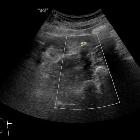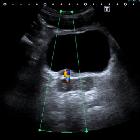twinkle artefact







Twinkling artifact is seen with color flow Doppler ultrasound . It occurs as a focus of alternating colors on Doppler signal behind a reflective object (such as a calculus), which gives the appearance of turbulent blood flow . It appears with or without an associated color comet-tail artifact .
The underlying mechanism of this artifact is thought to be a result of inherent noise within the ultrasound scanner, specifically phase (a.k.a. clock) jitter within the Doppler electronics .
Twinkling artifact is more sensitive for detection of small stones (e.g. urolithiasis, cholelithiasis) than is acoustic shadowing. It is most pronounced when the reflecting surface is rough and highly dependent on machine setting:
- when the focal zone is located below a rough reflecting surface, the twinkling artifact becomes more obvious than when it is above it
- decreased pulse repetition frequency facilitates better visualization of the artifact
The presence of renal twinkling artifact on sonography has a high positive predictive value (78%) for the presence of nephrolithiasis at unenhanced CT .
History and etymology
The first description of twinkling artifact was by the French radiologist Alain Rahmouni (1957-2018) et al in 1996 .
See also
Siehe auch:

 Assoziationen und Differentialdiagnosen zu Twinklingartefakte:
Assoziationen und Differentialdiagnosen zu Twinklingartefakte:

